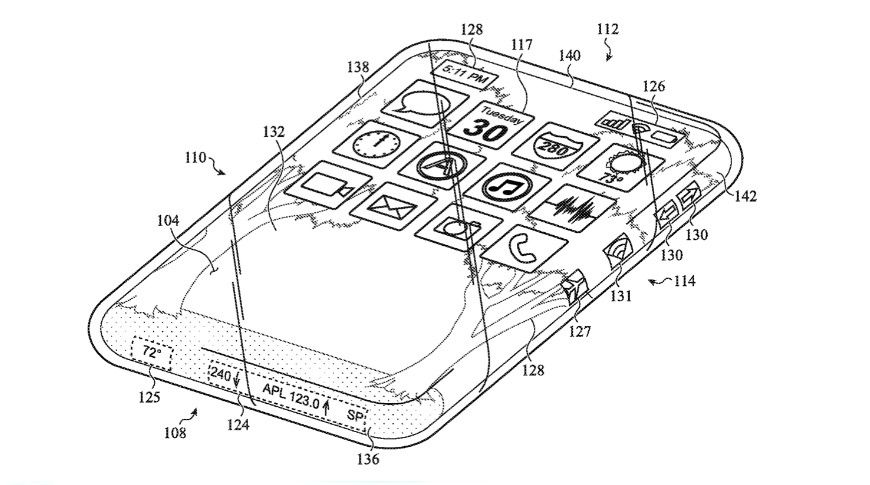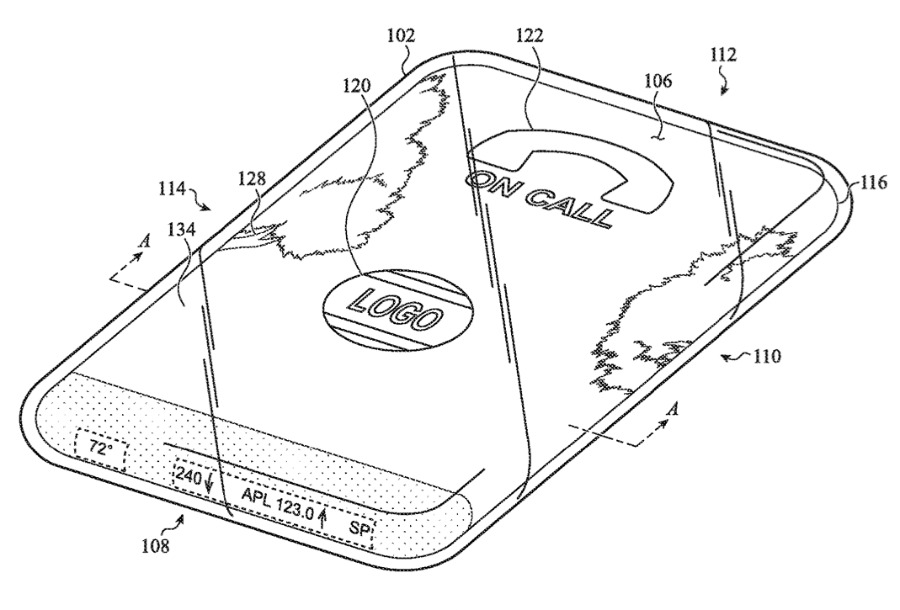Apple researching all-glass iPhone with wraparound touchscreen
Detail from a patent drawing. Note how the wallpaper stretches over the side, and the edges display touch-controls, or Complications-like data

New Apple research describes an all-glass iPhone which can display information, icons, and images on any surface — with the entire device touch sensitive.
The days of having to hold an iPhone vertically to make Face ID work may be numbered. So may the very idea of holding the phone the "right" way around, as a new Apple patent describes an iPhone which has little need or even indication of a correct orientation.
"Electronic Device with Glass Enclosure" describes an iPhone that comprises "a six-sided glass enclosure."
It is still the case that a front or "at least a portion of the first major side of the six-sided enclosure," will show most of the controls and display most apps.
"Conventionally, glass has been used in such devices to provide a transparent window over a touchscreen on a front of the device," says the patent. "Described herein, however, are electronic devices with enclosures that use glass to define multiple sides of the enclosure... In such cases, the enclosure may appear visually and tactilely seamless, such that the entire enclosure may appear to be formed from a single piece of glass (even though it may be formed from multiple separate pieces attached together)."
As well as this aesthetic benefit from an apparently seamless iPhone, all of the glass may be functional.
"Enclosures having glass defining multiple sides of the enclosure may facilitate or enable numerous additional functions and uses that are not realized with conventional enclosures," it continues. "For example, glass backs and glass sides may be transparent, allowing the electronic device to include additional displays that are viewable through the sides and/or the back. Moreover, the side- and back-viewable displays may be made touch and/or force sensitive using touch- and/or force-sensing systems, effectively turning the side and back surfaces into additional input devices or surfaces with which a user may interact to control the electronic device."
This could mean replacing the hardware mute switch, sleep/wake button, or volume controls, with touch-sensing areas. Apple might use a force-sensing to allow users to squeeze an iPhone, perhaps thereby telling it to send a call to voicemail.
From the drawings included with the patent, Apple is also looking at utilizing the edges of the phone to display information. There could be app-like icons on the that give one-tap access to Airplane Mode or Wi-Fi.
The examples shown include Apple Watch-like Complications such as readouts of the current weather, or scrolling data from the Stocks app.
Apple shows wallpaper that stretches from the front and over the sides, showing a rounded taper rather than a distinct edge to the device. However, Apple does distinguish between these edges, calling the sides, top and bottom of the device "peripheral sides."
"[Multiple glass sides] may display graphical outputs (e.g., images, videos, etc.) that span multiple displays and sides of the device," says Apple. "For example, a single displayed graphical output (e.g., image, user interface, etc.) may wrap or extend over a front side, one or more peripheral sides, and a back side of the device, thus contributing to the unified appearance of the multiple sides.
With the sides being at least partly touch-enabled, "icons [may be allowed] to move across multiple surfaces when swiped, and may even... appear as a ribbon-like user interface that wraps around the device," says Apple.
The idea is to get away from the notion of front, back and sides, and instead "minimize such distinctions to form a functionally and visually unified display region that spans multiple surfaces."
Apple's Christopher D. Prest and Peter N. Russell-Clarke are credited as inventors. Prest is named in over 130 previous patents, including many related ones such as "Glass fastening and sealing systems," and "Multiple-element light-bending structures for minimizing display borders."
Similarly, Russell-Clarke has more than 30 prior patents, including "Glass device housings," and "Fused opaque and clear glass for camera or display window."
This patent follows one in November 2019 which also described a wraparound iPhone, though of a somewhat different design. The company has also been investigating flexible components, as well as possible folding displays.
 William Gallagher
William Gallagher












 Malcolm Owen
Malcolm Owen
 Marko Zivkovic
Marko Zivkovic
 William Gallagher and Mike Wuerthele
William Gallagher and Mike Wuerthele

 Wesley Hilliard
Wesley Hilliard
 Andrew Orr
Andrew Orr






